Long-Term Studies of Cyg X-3 High-Mass X-ray Binary
Abstract
1. Introduction
2. Multiwavelength Observations
2.1. Radio Observations
2.2. X-ray Observations
2.3. High Energy Observations by Fermi-LAT
3. Cyg X-3 Characteristics at Very High Energies
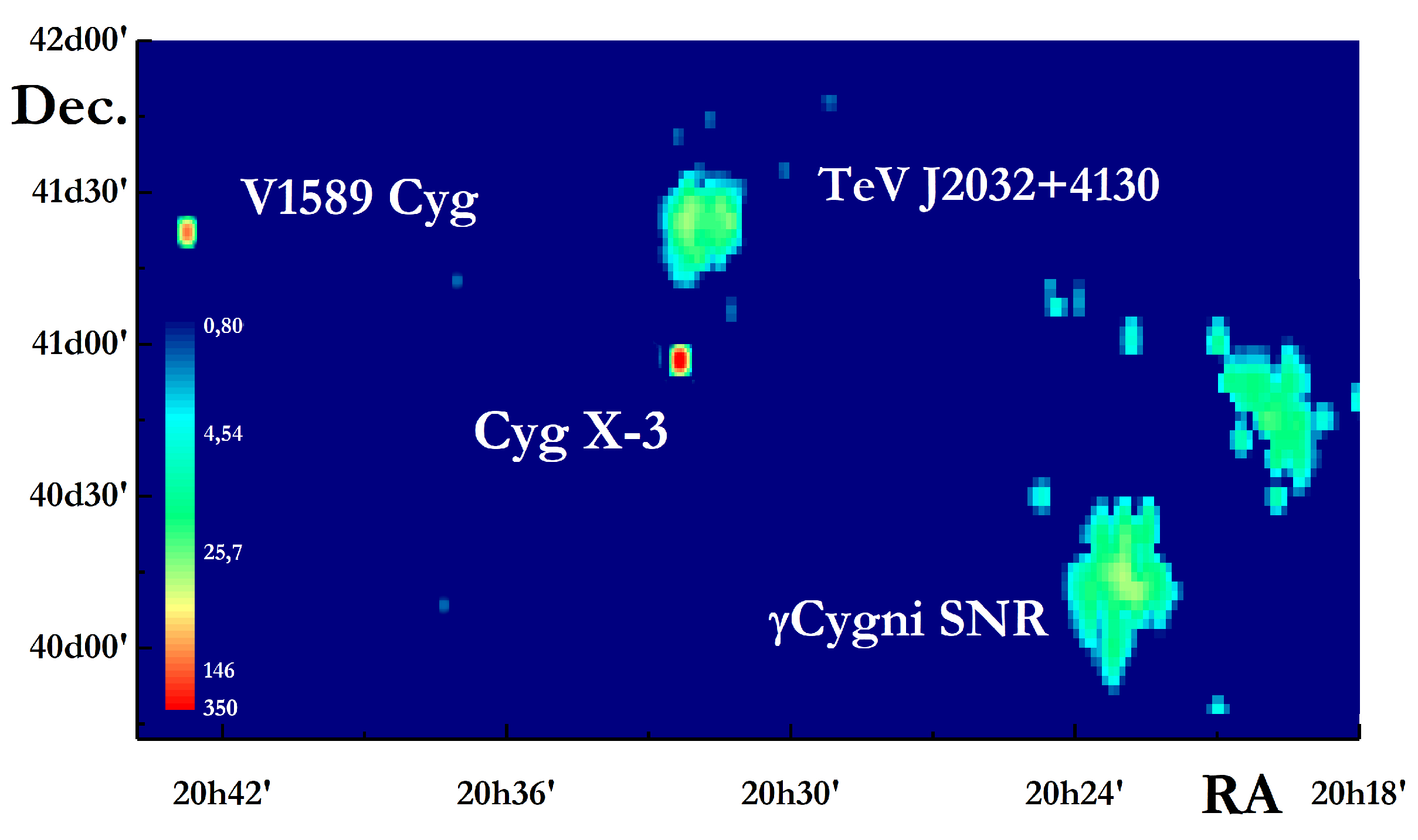

3.1. Orbital Modulation
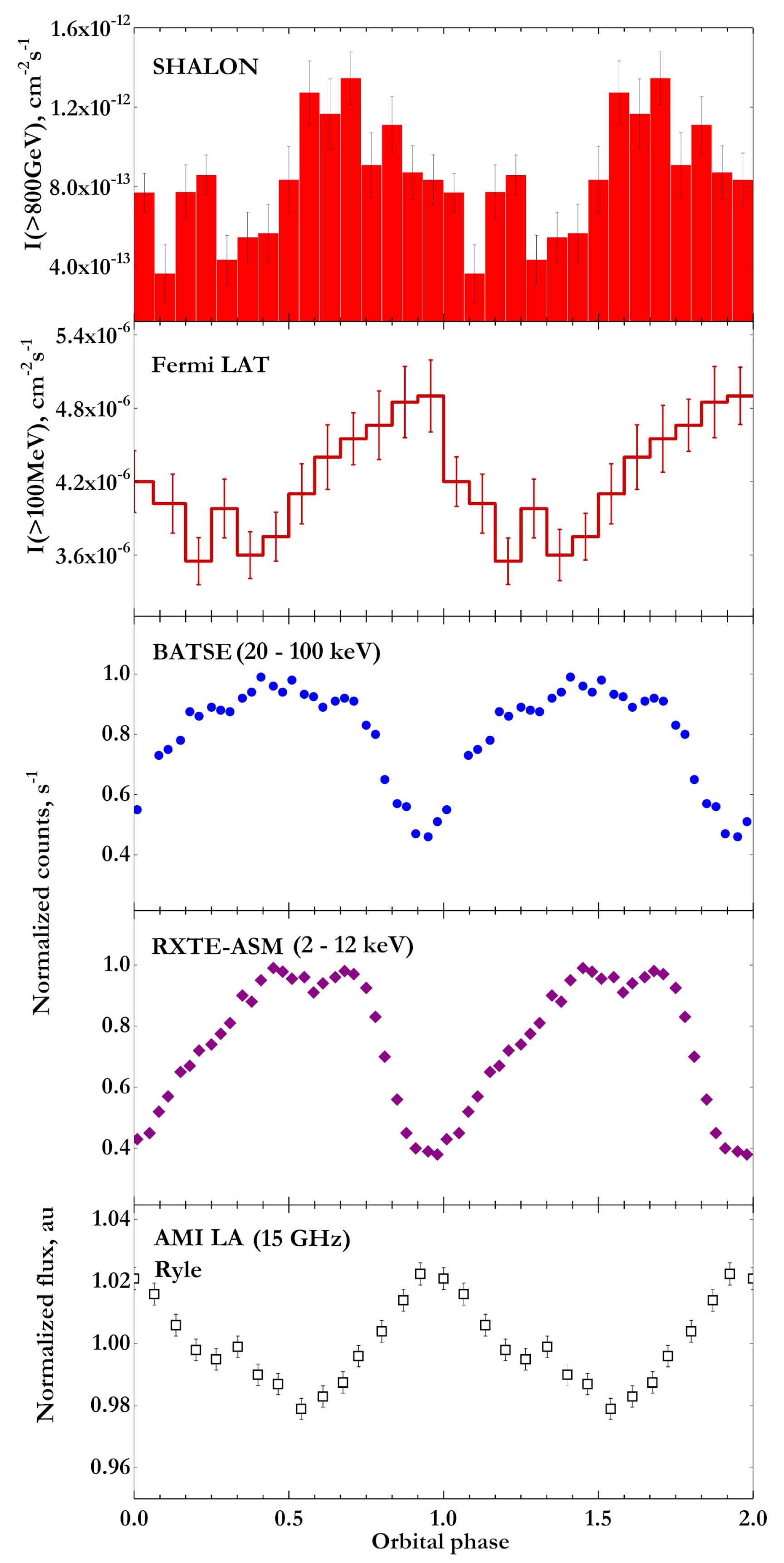
3.2. Cyg X-3 Flaring Activity
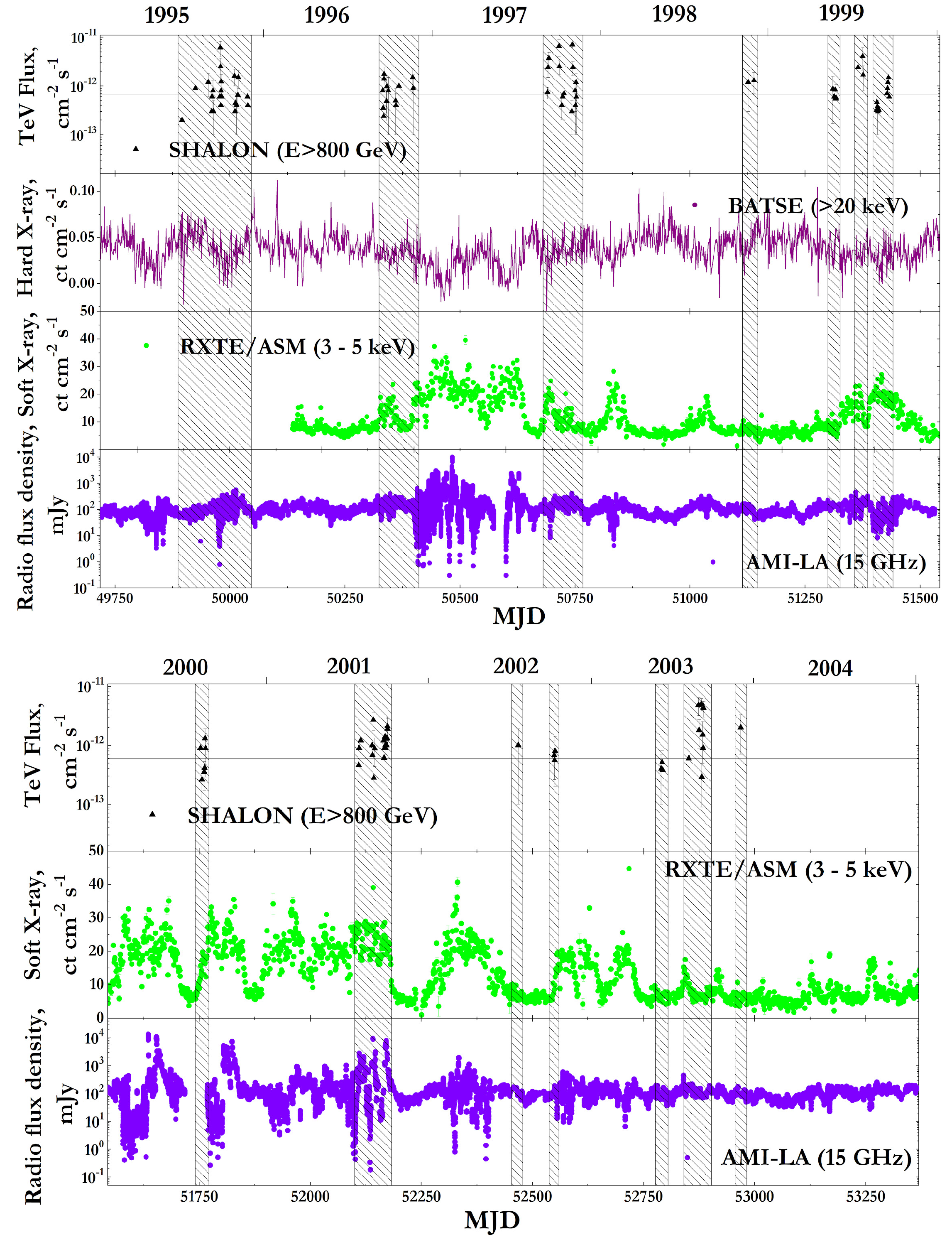



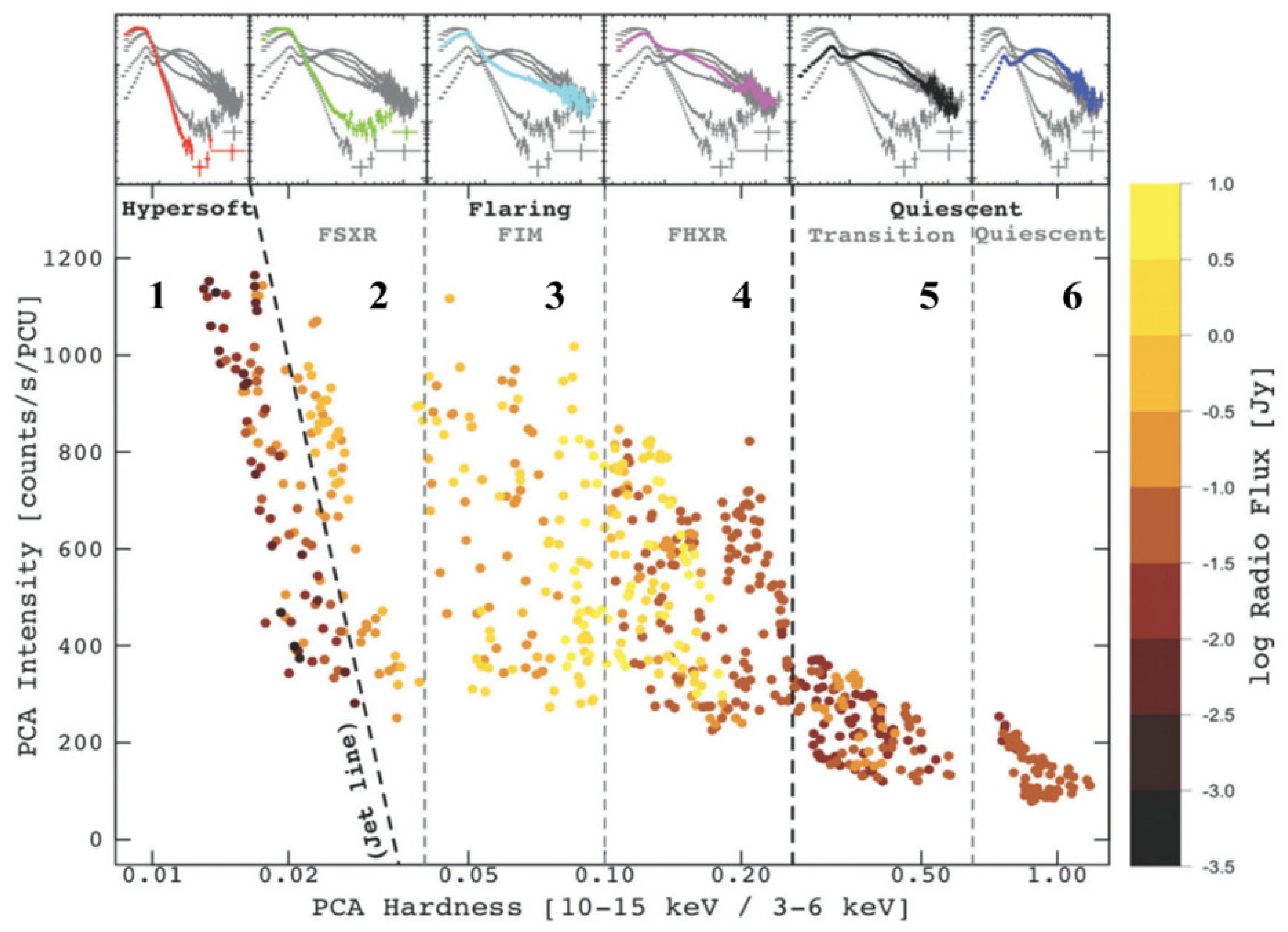
4. Results and Discussion on the Origin of TeV Emission from Cyg X-3
Author Contributions
Funding
Conflicts of Interest
| 1 | http://www.mrao.cam.ac.uk/~guy/cx3/, accessed on 26 September 2017. |
| 2 | http://xte.mit.edu/asmlc/srcs/cygx3.html, accessed on 16 September 2021. |
| 3 | http://maxi.riken.jp/pubdata/v7l/J2032+409/index.html, accessed on 16 September 2021. |
| 4 | https://gammaray.nsstc.nasa.gov/batse/occultation/list.html, accessed on 16 September 2021. |
| 5 | http://swift.gsfc.nasa.gov/results/transients/CygX-3, accessed on 16 September 2021. |
| 6 | https://fermi.gsfc.nasa.gov/ssc/data/access/lat/10yr_catalog, accessed on 16 September 2021. |
References
- Giacconi, R.; Gorenstein, P.; Gursky, H.; Walter, J.R. An X-ray survey of the Cygnus Region. Astrophys. J. 1967, 148, L119. [Google Scholar] [CrossRef]
- Hillas, A.M. Is Cygnus X-3 a monoenergetic 1017 eV accelerator? Nature 1984, 312, 50. [Google Scholar] [CrossRef]
- Cordova, F.A.-D. Cygnus X-3 and the Case for Simultaneous Multifrequency Observations. Los Alamos Sci. 1986, 13, 38. [Google Scholar]
- van Kerkwijk, M.H.; Charles, P.A.; Geballe, T.R.; King, D.L.; Miley, G.K.; Molnar, L.A.; van den Heuvel, E.P.J.; van der Klis, M.; van Paradijs, J. Infrared helium emission lines from Cygnus X-3 suggesting a Wolf-Rayet star companion. Nature 1992, 355, 703. [Google Scholar] [CrossRef]
- van den Heuvel, E.P.J. High-Mass X-ray Binaries: Progenitors of double compact objects. In Proceedings of the International Astronomical Union Symposium Nr. 346, Vienna, Austria, 27–31 August 2018. [Google Scholar]
- Cherepashchuk, A.M.; Moffat, A.F.J. Cygnus X-3 as a benchmark for fundamental properties of Wolf-Rayet stars. Astrophys. J. 1994, 454, L53. [Google Scholar] [CrossRef]
- Hjalmarsdotter, L.; Zdziarski, A.A.; Larsson, S.; Beckmann, V.; McCollough, M.; Hannikainen, D.C.; Vilhu, O. Spectral variability in Cygnus X-3. MNRAS 2008, 384, 278. [Google Scholar] [CrossRef]
- Hjalmarsdotter, L.; Zdziarski, A.A.; Szostek, A.; Hannikainen, D.C. Spectral variability in Cygnus X-3. MNRAS 2009, 392, 251. [Google Scholar] [CrossRef][Green Version]
- Szostek, A.; Zdziarski, A.A. Effects of the stellar wind on X-ray spectra of Cygnus X-3. MNRAS 2008, 386, 593. [Google Scholar] [CrossRef]
- Szostek, A.; Zdziarski, A.A.; McCollough, M.L. A classification of the X-ray and radio states of Cyg X-3 and their long-term correlations. MNRAS 2008, 388, 1001. [Google Scholar] [CrossRef]
- Koljonen, K.I.I.; Hannikainen, D.C.; McCollough, M.L.; Pooley, G.G.; Trushkin, S.A. The hardness–intensity diagram of Cygnus X-3: Revisiting the radio/X-ray states. MNRAS 2010, 406, 307. [Google Scholar] [CrossRef]
- Koljonen, K.I.I.; Maccarone, T.; McCollough, M.L.; Gurwell, M.; Trushkin, S.A.; Pooley, G.G.; Piano, G.; Tavani, M. The hypersoft state of Cygnus X–3-A key to jet quenching in X-ray binaries? Astron. Astrophys. 2018, 612, A27. [Google Scholar] [CrossRef]
- Ling, Z.; Zhang, S.N.; Tang, S. Determining the distance of Cyg X-3 with its X-ray dust scattering halo. Astrophys. J. 2009, 695, 1111. [Google Scholar] [CrossRef]
- Fender, R.P.; Bell-Burnell, S.J.; Williams, P.M.; Webster, A.S. Flaring and quiescent infrared behaviour of Cygnus X-3. MNRAS 1996, 283, 798. [Google Scholar] [CrossRef]
- Apparao, K.M.V. Flaring and modulation of infrared radiation from the X-ray source Cygnus X-3. Astron. Astrophys. 1997, 328, 595. [Google Scholar]
- Gregory, P.C.; Kronberg, P.P.; Seaquist, E.R.; Hughes, V.A.; Woodsworth, A.; Viner, M.R.; Retallack, D. Discovery of giant radio outburst from Cygnus X-3. Nature 1972, 239, 440. [Google Scholar] [CrossRef]
- Waltman, E.B.; Fiedler, R.L.; Johnston, K.J.; Ghigo, F.D. The quiescent level of Cygnus X-3 at 2.25 and 8.3 GHz: 1988-1992. Astron. J. 1994, 108, 179. [Google Scholar] [CrossRef]
- Waltman, E.B.; Ghigo, F.D.; Johnston, K.J.; Foster, R.S.; Fiedler, R.L.; Spencer, J.H. The evolution of outbursts in Cygnus X-3 at 2.25 and 8.3 GHz. Astron. J. 1995, 110, 290. [Google Scholar] [CrossRef]
- Trushkin, S.A.; Nizhelskij, N.A.; Tsybulev, P.G.; Zhekanis, G.V. The giant radio flare of Cygnus X-3 in September 2016. arXiv 2016, arXiv:1612.00634. [Google Scholar]
- Watanabe, H.; Kitamoto, S.; Miyamoto, S.; Fielder, R.L.; Waltman, E.B.; Johnston, K.J.; Ghigo, F.D. Correlation between X-ray intensity and radio outbursts of Cygnus X-3. Astrophys. J. 1994, 433, 350. [Google Scholar] [CrossRef]
- McCollough, M.L.; Robinson, C.R.; Zhang, S.N.; Harmon, B.A.; Hjellming, R.M.; Waltman, E.B.; Foster, R.S.; Ghigo, F.D.; Briggs, M.S.; Pendleton, G.N. Discovery of correlated behavior between the hard X-ray and the radio bands in Cygnus X-3. Astrophys. J. 1999, 517, 951. [Google Scholar] [CrossRef]
- Tudose, V.; Miller-Jones, J.C.A.; Fender, R.P.; Paragi, Z.; Sakari, C.; Szostek, A.; Garrett, M.A.; Dhawan, V.; Rushton, A.; Spencer, R.E. Probing the behaviour of the X-ray binary Cygnus X-3 with very long baseline radio interferometry. MNRAS 2010, 401, 890. [Google Scholar] [CrossRef]
- Molnar, L.A.; Reid, M.J.; Grindlay, J.E. Low-level radio flares from Cygnus X-3. Nature 1984, 310, 662. [Google Scholar] [CrossRef]
- Hjalmarsdotter, L.; Hannikainen, D.; Vilhui, O.; Zdziarski, A.A.; Trushkin, S.; McCollough, M.; Pooley, G.; Hakala, P.; Paizis, A. Cygnus X-3 in the INTEGRAL era Based on observations with INTEGRAL, an ESA project with instruments and science data center funded by ESA and member states (especially the PI countries: Denmark, France, Germany, Italy, Switzerland, and Spain), the Czech Republic, and Poland and with the participation of Russia and the US. Chin. J. Astron. Astrophys. Suppl. 2003, 3, 425. [Google Scholar]
- Zdziarski, A.A.; Malyshev, D.; Dubus, G.; Pooley, G.G.; Johnson, T.; Frankowski, A.; De Marco, B.; Chernyakova, M.; Rao, A.R. A comprehensive study of high-energy gamma-ray and radio emission from Cyg X-3. MNRAS 2018, 479, 4339. [Google Scholar] [CrossRef]
- Fermi LAT Collaboration; Abdo, A.A.; Ackermann, M.; Ajello, M.; Axelsson, M.; Baldini, L.; Ballet, J.; Barbiellini, G.; Bastieri, D.; Baughman, B.M.; et al. Modulated high-energy gamma-ray emission from the microquasar Cygnus X-3. Science 2009, 326, 1512. [Google Scholar]
- Tavani, M.; Bulgarelli, A.; Piano, G.; Sabatini, S.; Striani, E.; Evangelista, Y.; Trois, A.; Pooley, G.; Trushkin, S.; Nizhelskij, N.A.; et al. Extreme particle acceleration in the microquasar Cygnus X-3. Nature 2009, 462, 620. [Google Scholar] [CrossRef] [PubMed]
- Dubus, G.; Cerutti, B.; Henri, G. The relativistic jet of Cygnus X-3 in gamma-rays. MNRAS 2010, 404, L55. [Google Scholar] [CrossRef]
- Cocconi, G. Proceedings of the VI International Cosmic Ray Conference (ICRC VI), Moscow, Russia, 6–11 July 1960; Volume 2, p. 309.
- Samorski, M.; Stamm, W. Detection of 2×1015 to 2×1016 eV gamma-rays from Cygnus X-3. Astrophys. J. 1983, 268, L17. [Google Scholar] [CrossRef]
- Lloyd-Evans, J.; Coy, R.N.; Lambert, A.; Lapikens, J.; Patel, M.; Reid, R.J.O.; Watson, A.A. Observation of γ-rays > 1015 eV from Cygnus X-3. Nature 1983, 305, 784. [Google Scholar] [CrossRef]
- Borione, A.; Chantell, M.C.; Covault, C.E.; Cronin, J.W.; Fick, B.E.; Fowler, J.W.; Fortson, L.F.; Gibbs, K.G.; Green, K.D.; Newport, B.J.; et al. High statistics search for ultrahigh energy γ-ray emission from Cygnus X-3 and Hercules X-1. Phys. Rev. D 1997, 55, 1714. [Google Scholar] [CrossRef]
- Cronin, J.W. Gamma-ray astronomy by the air shower technique: Performance and perspectives. Nuovo Cimento C 1996, 19, 847. [Google Scholar] [CrossRef]
- Zwart, J.T.L.; Barker, R.W.; Biddulph, P.; Bly, D.; Boysen, R.C.; Brown, A.R.; Clementson, C.; Crofts, M.; Culverhouse, T.L.; Czeres, J.; et al. The arcminute microkelvin imager. MNRAS 2008, 391, 1545. [Google Scholar] [CrossRef]
- Levine, A.M.; Bradt, H.; Cui, W.; Jernigan, J.G.; Morgan, E.H.; Remillard, R.; Shirey, R.E.; Smith, D.A. First results from the all-sky monitor on the rossi X-ray timing explorer. Astrophys. J. Lett. 1996, 469, L33. [Google Scholar] [CrossRef]
- Matsuoka, M.; Kawasaki, K.; Ueno, S.; Tomida, H.; Kohama, M.; Suzuki, M.; Adachi, Y.; Ishikawa, M.; Mihara, T.; Sugizaki, M.; et al. The MAXI mission on the ISS: Science and instruments for monitoring all-sky X-ray images. PASJ 2009, 61, 999. [Google Scholar] [CrossRef]
- Fishman, G.J.; Meegan, C.A.; Wilson, R.B.; Paciesas, W.S.; Parnell, T.A.; Austin, R.W.; Rehage, J.R.; Matteson, J.L.; Teegarden, B.J.; Cline, T.L.; et al. BATSE: The Burst and Transient Source Experiment on the gamma-ray observatory. In Proceedings of the Gamma Ray Observatory Science Workshop, Greenbelt, MD, USA, 10–12 April 1989; Johnson, W.N., Ed.; Goddard: Greenbelt, MD, USA, 1989; pp. 2–39. [Google Scholar]
- Krimm, H.A.; Holland, S.T.; Corbet, R.H.D.; Pearlman, A.B.; Romano, P.; Kennea, J.A.; Bloom, J.S.; Barthelmy, S.D.; Baumgartner, W.H.; Cummings, J.R.; et al. The Swift/BAT hard X-ray transient monitor. Astrophys. J. Supp. 2013, 209, 14. [Google Scholar] [CrossRef]
- Atwood, W.B.; Abdo, A.A.; Ackermann, M.; Althouse, W.; Anderson, B.; Axelsson, M.; Baldini, L.; Ballet, J.; Band, D.L.; Barbiellini, G.; et al. The large area telescope on the Fermi gamma-ray space telescope mission. Astrophys. J. 2009, 697, 1071. [Google Scholar] [CrossRef]
- Nikolsky, S.I.; Sinitsyna, V.G. Investigation of gamma-sources by mirror telescope. In Proceedings of the Int. Workshop of Very Hight Energy Gamma-ray Astronomy, Crimea, Russia, 17–21 April 1989; Stepanian, A.A., Fegan, D.J., Cawley, W.F., Eds.; p. 11. [Google Scholar]
- Sinitsyna, V.G. Searches for gamma-quanta from local sources by a wide-angle imaging telescope. Nuovo Cimento C 1996, 19, 965. [Google Scholar] [CrossRef]
- Sinitsyna, V.G.; Sinitsyna, V.Y. Emission from the galaxy NGC 1275 at high and very high energies and its origin. Astron. Lett. 2014, 40, 91. [Google Scholar] [CrossRef]
- Sinitsyna, V.G.; Sinitsyna, V.Y.; Borisov, S.S.; Klimov, A.I.; Mirzafatikhov, R.M.; Moseiko, N.I. Very high energy astrophysics with the SHALON Cherenkov telescopes. Nucl. Instrum. Methods Phys. Res. A 2020, 952, 161775. [Google Scholar] [CrossRef]
- Sinitsyna, V.G.; Arsov, T.P.; Alaverdyan, A.Y.; Borisov, S.S.; Galitskov, A.N.; Ivanov, I.A.; Kasparov, G.M.; Klevalin, V.A.; Malisko, A.A.; Musin, F.M.; et al. Stereoscopic Cherenkov Telescope System Shalon Alatoo. In Proceedings of the 27th International Cosmic Ray Conference (ICRC27), Hamburg, Germany, 7–15 August 2001; Schlickeiser, R., Ed.; Copernicus: Hamburg, Germany; Volume OG 2.5, pp. 2798–2801. [Google Scholar]
- Sinitsyna, V.G. SHALON. In Proceedings of the International Workshop, Towards a Major Atmospheric Cherenkov Detector V, Kruger Park, South Africa, 8–11 August 1997; De Jager, O., Ed.; Westprint: Potchefstroom, South Africa, 1997; pp. 190–195. [Google Scholar]
- Moseiko, N.I.; Klimov, A.I.; Sinitsyna, V.G.; Sinitsyna, V.Y.; Balygin, K.A.; Borisov, S.S.; Kirichenko, A.M.; Mirzafatikhov, R.M.; Ostashev, I.E. An analog-to-digital converter and intelligent controller for use in a DAQ system processing PMT signals from very high energy astrophysics experiments. Nucl. Instrum. Methods Phys. Res. A 2020, 952, 161755. [Google Scholar] [CrossRef]
- Hillas, A.M. Cerenkov light images of EAS produced by primary gamma. In Proceedings of the 19th International Cosmic Ray Conference (ICRC19), La Jolla, CA, USA, 11–23 August 1985; NASA, Goddard Space Flight Center: Greenbelt, MD, USA, 1985; Volume 3, pp. 445–448. [Google Scholar]
- Sinitsyna, V.G.; Sinitsyna, V.Y. Very High Energy Emission from the Binary System Cyg X-3. Astron. Lett. 2018, 44, 162. [Google Scholar] [CrossRef]
- Goncharskii, A.V.; Cherepashchuk, A.M.; Yagola, A.G. Ill-Posed Problems in Astrophysics; Nauka, Fizmatlit: Moscow, Russia, 1985. [Google Scholar]
- Li, T.-P.; Ma, Y.-Q. Analysis methods for results in gamma-ray astronomy. Astrophys. J. Astrophys. J. 1983, 272, 317. [Google Scholar] [CrossRef]
- Sinitsyna, V.G.; Sinitsyna, V.Y.; Borisov, S.S.; Ivanov, I.A.; Klimov, A.I.; Mirzafatikhov, R.M.; Moseiko, N.I. Shell-type supernova remnants as sources of cosmic rays. Adv. Space Res. 2018, 62, 2845. [Google Scholar] [CrossRef]
- Sinitsyna, V.G. Intensity TeV gamma-rays Crab Nebula and Markarian-421 by SHALON-detected. In Proceedings of the Workshop on Towards a Major Atmospheric Cherenkov Detector—IV, Padova, Italy, 11–13 September 1995; Cresti, M., Ed.; University of Padova: Padova, Italy, 1995; p. 133. [Google Scholar]
- Sinitsyna, V.G. Spectrum High Energy Gamma-Quanta from Cygnus X-3. In Proceedings of the 16th European Cosmic Ray Symposium, Alcala de Henares, Spain, 20–25 July 1998; Medina, J., Ed.; Universidad de Alcalá: Alcalá de Henares, Spain, 1998; p. 383. [Google Scholar]
- Sinitsyna, V.G.; Sinitsyna, V.Y. Long-term studies of the Cygnus Region and its objects: Cyg X-3 and γCygni SNR. J. Phys. Conf. Ser. 2016, 718, 052040. [Google Scholar] [CrossRef]
- Sinitsyna, V.G.; Sinitsyna, V.Y. Long-term observations of the Cyg X-3 and γCygni SNR at ultrahigh energies by SHALON mirror Cherenkov telescopes. Bull. Lebedev Phys. Inst. 2013, 40, 113. [Google Scholar] [CrossRef]
- Sinitsyna, V.G.; Sinitsyna, V.Y.; Stozhkov, Y.I. Red dwarfs as sources of cosmic rays and detection of TeV gamma-rays from these stars. Adv. Space Res. 2019, 64, 2585–2594. [Google Scholar] [CrossRef]
- Archambault, S.; Beilicke, M.; Benbow, W.; Berger, K.; Bird, R.; Bouvier, A.; Buckley, J.H.; Bugaev, V.; Byrum, K.; Cerruti, M.; et al. VERITAS observations of the microquasar Cygnus X-3. Astrophys. J. 2013, 779, 150. [Google Scholar] [CrossRef]
- Aleksić, J.; Antonelli, L.A.; Antoranz, P.; Backes, M.; Baixeras, C.; Barrio, J.A.; Bastieri, D.; González, J.B.; Bednarek, W.; Berdyugin, A.; et al. Magic Constraints on γ-ray Emission from Cygnus X-3. Astrophys. J. 2010, 721, 843. [Google Scholar] [CrossRef]
- Parsignault, D.R.; Schreier, E.; Grindlay, J.; Gurskyet, H. On the stability of the period of Cygnus X-3. Astrophys. J. 1976, 209, L73. [Google Scholar] [CrossRef]
- van der Klis, M.; Bonnet-Bidaud, J.M. The X-ray ephemeris of Cygnus X-3. Astron. Astrophys. 1989, 214, 203. [Google Scholar]
- Kitamoto, S.; Hirano, A.; Kawashima, K.; Miyamoto, S.; Nagase, F.; White, N.E.; Smale, A.P.; Soong, Y.; Matsuoka, M.; Kawai, N.; et al. Orbital Period Changes of Cygnus X-3. Astron. Soc. Jpn. 1995, 47, 233. [Google Scholar]
- van Kerkwijk, M.H.; Geballe, T.R.; King, D.L.; van Der Klis, M.; van Paradijs, J. The Wolf-Rayet counterpart of Cygnus X-3. Astron. Astrophys. 1996, 314, 521. [Google Scholar]
- Singh, N.S.; Naik, S.; Paul, B.; Agrawal, P.C.; Rao, A.R.; Singh, K.Y. New measurements of orbital period change in Cygnus X-3. Astron. Astrophys. 2002, 392, 161. [Google Scholar] [CrossRef]
- Manzo, G.; Molteni, D.; Robba, N.R. Evidence of a Continuous Change in the Period of Cygnus X-3. Astron. Astrophys. 1978, 70, 317. [Google Scholar]
- Elsner, R.F.; Ghosh, P.; Darbro, W.; Weisskopf, M.C.; Sutherland, P.G.; Grindlay, J.E. Observations of Cygnus X-3 with the Einstein/HEAO 2/X-ray Observatory The period derivative and the asymmetric X-ray light curve. Astrophys. J. 1980, 239, 335. [Google Scholar] [CrossRef]
- Matz, S.M. The orbital ephemeris and X-ray light curve of Cyg X-3. In Proceedings of the the 4th Compton Symposium, Williamsburg, VA, USA, 28–30 April 1997; Dermer, C.D., Strickman, M.S., Kurfess, J.D., Eds.; Volume 410, pp. 808–812. [Google Scholar]
- Goldoni, P.; Bonnet-Bidaud, J.M.; Falanga, M.; Goldwurm, A. First results of IBIS/ISGRI Cygnus X-3 monitoring during INTEGRAL PV phase. Astron. Astrophys. 2003, 411, L399. [Google Scholar] [CrossRef]
- Choudhury, M.; Rao, A.R.; Vadawale, S.V.; Ishwara-Chandra, C.H.; Jain, A.K. Disk-jet connection in Cygnus X-3. Astron. Astrophys. 2002, 383, L35. [Google Scholar] [CrossRef]
- Heinz, S.; Sunyaev, R. Cosmic rays from microquasars: A narrow component to the CR spectrum? Astron. Astrophys. 2002, 390, 751. [Google Scholar] [CrossRef]
- Mioduszewski, A.J.; Rupen, M.P.; Hjellming, R.M.; Pooley, G.G.; Waltman, E.B. A one-sided highly relativistic jet from Cygnus X-3. Astrophys. J. 2001, 553, 766. [Google Scholar] [CrossRef]
- Vilhu, O.; Hakala, P.; Hannikainen, D.C.; McCollough, M.; Koljonen, K. Orbital modulation of X-ray emission lines in Cygnus X-3. Astron. Astrophys. 2009, 501, 679. [Google Scholar] [CrossRef][Green Version]
- Zdziarski, A.A.; Sikora, M.; Dubus, G.; Yuan, F.; Cerutti, B.; Ogorzałek, A. The gamma-ray emitting region of the jet in Cyg X-3. MNRAS 2012, 421, 2956. [Google Scholar] [CrossRef]
- Sahakyan, N.; Piano, G.; Tavani, M. Hadronic gamma-ray and neutrino emission from Cygnus X-3. Astrophys. J. 2014, 780, 29. [Google Scholar] [CrossRef][Green Version]
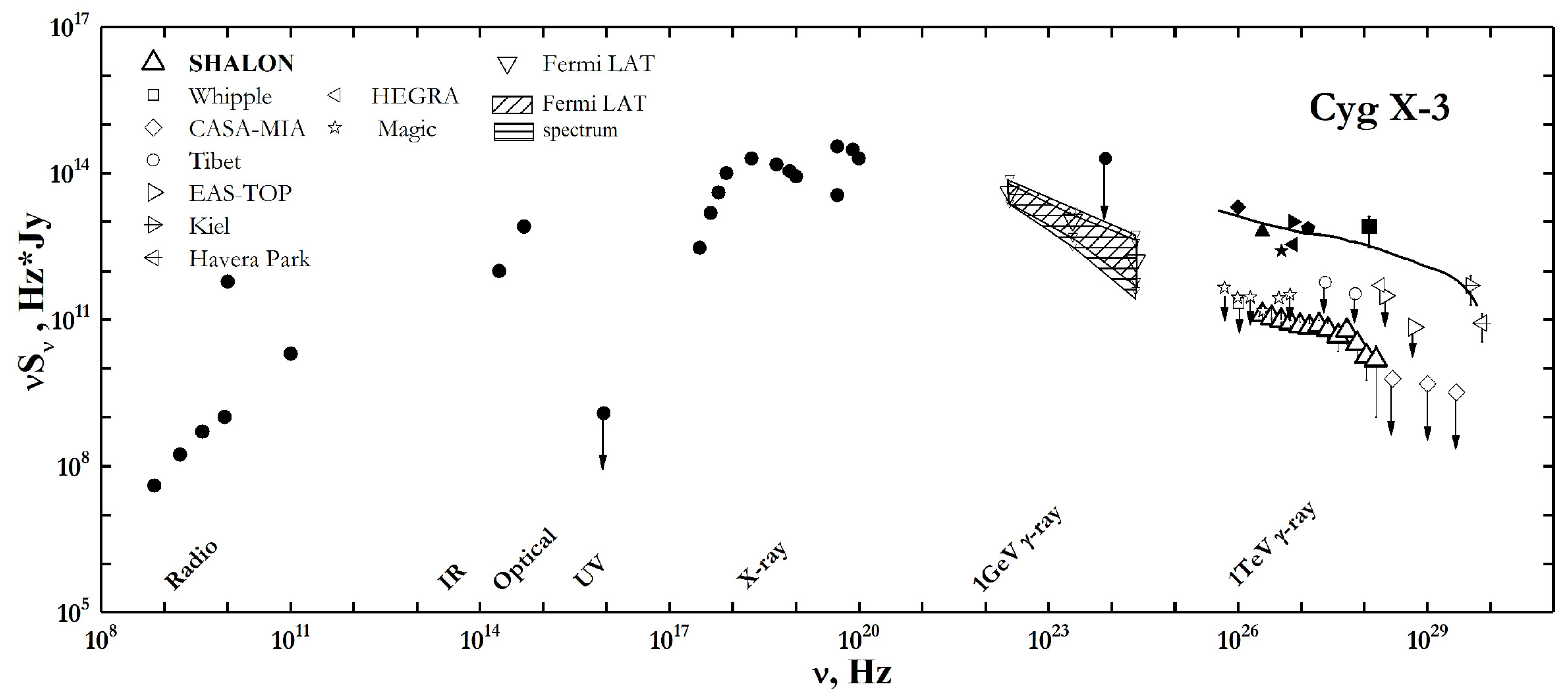
Publisher’s Note: MDPI stays neutral with regard to jurisdictional claims in published maps and institutional affiliations. |
© 2022 by the authors. Licensee MDPI, Basel, Switzerland. This article is an open access article distributed under the terms and conditions of the Creative Commons Attribution (CC BY) license (https://creativecommons.org/licenses/by/4.0/).
Share and Cite
Sinitsyna, V.G.; Sinitsyna, V.Y. Long-Term Studies of Cyg X-3 High-Mass X-ray Binary. Universe 2022, 8, 57. https://doi.org/10.3390/universe8020057
Sinitsyna VG, Sinitsyna VY. Long-Term Studies of Cyg X-3 High-Mass X-ray Binary. Universe. 2022; 8(2):57. https://doi.org/10.3390/universe8020057
Chicago/Turabian StyleSinitsyna, Vera G., and Vera Yu. Sinitsyna. 2022. "Long-Term Studies of Cyg X-3 High-Mass X-ray Binary" Universe 8, no. 2: 57. https://doi.org/10.3390/universe8020057
APA StyleSinitsyna, V. G., & Sinitsyna, V. Y. (2022). Long-Term Studies of Cyg X-3 High-Mass X-ray Binary. Universe, 8(2), 57. https://doi.org/10.3390/universe8020057




